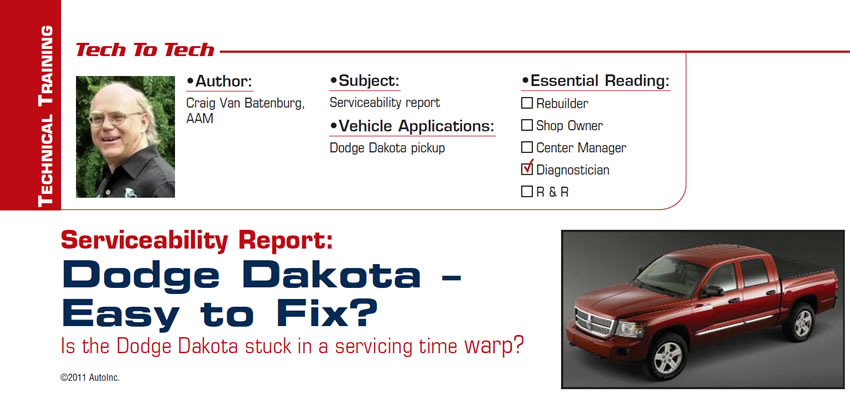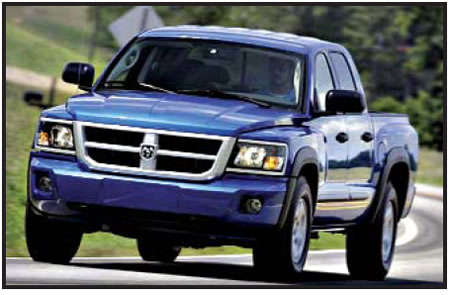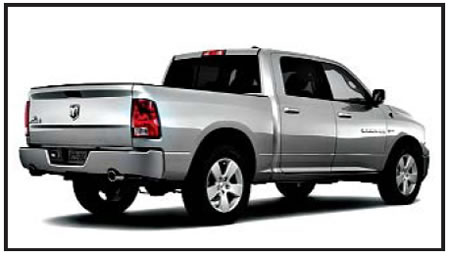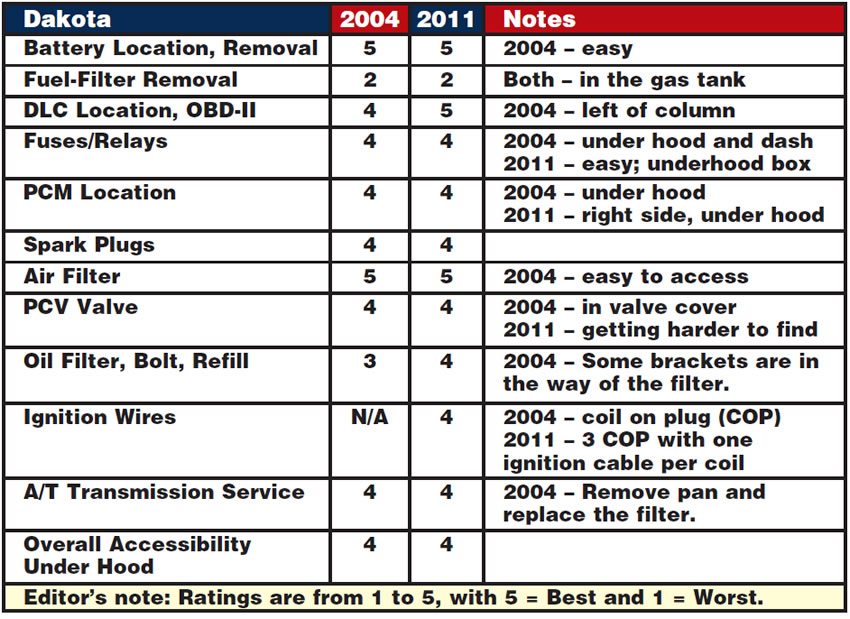
Tech to Tech
- Subject: Serviceability report
- Vehicle Application: Dodge Dakota pickup
- Essential Reading: Diagnostician
- Author: Craig Van Batenburg, AAM
Is the Dodge Dakota stuck in a servicing time warp?
The top six car and truck companies in the United States are Toyota, GM, Ford, Honda, Chrysler and Nissan. The Dodge brand is coming back. Big truck and SUV sales are slowing down, and smaller trucks are on an upward trend, so you will be seeing more of them in the future. Let’s look at this segment.
In 2000 the Dakota hit sales of more than 175,000 units, but last year it was a dismal 13,000. The V-6 is the best-selling engine because the RAM1500 gets about the same gas mileage as a Dakota with a V-8. Why write an article about a truck that appears to be dying? If Fiat can save Chrysler it will happen only if they sell vehicles, lots of them, so I think that if this truck stacks up well to the competition we should recommend it to our customers. We will compare the 2004 Dakota V-6 automatic 4WD to the 2011 model.
2004
The Dodge Dakota was first sold in 1987, and it gave Chrysler a unique pickup truck to market against the compact Ford Ranger, Chevy S-10 and the Toyota and Nissan pickups. From 1987 to 1996, it was the largest (in size) small truck offered in the United States. That meant owners could haul more and tow more without moving into a full-size truck. The first-generation Dakota came with a choice of four- and six-cylinder engines, rear- or four-wheel drive, and a single cab configuration – though a unique convertible model was sold from 1989 to 1991.

Midway through this model life, Dodge added a longer-cab model that still had only two doors, a halfway solution to the Dakota’s competition and its four-door models. Over the years many people came to enjoy the uniqueness of the Dakota. After many years of sales that were respectable, the truck needed an overhaul to compete with the Tacoma that was enlarged and gaining in market share. Enter the 2005-to-current.

2011
After 2004, the 2005 was sold with the option of a V-6 or one of two V-8 engines available. The standard engine was a 3.7L PowerTech V-6; the two 4.7L V-8 engines were the standard PowerTech V-8 and the V-8 high-output or HO. The 3.7L V-6 produces 210 horsepower and 235 pound-feet of torque. The standard-output 4.7L V-8 produced 230 hp and 295 pound-feet of torque. The high-output 4.7L V-8 produced 260 horsepower and 310 pound-feet of torque.

Both the 3.7L and standard-output 4.7L V-8s were available with the six-speed manual transmission in 2005 and 2006. For 2007, that option was deleted on the V-8 models. Automatics continue to dominate the truck world. What happened to the good old stickshift days?
Now the standard engine is the 3.7L V-6. As of 2010, the Dakota is considered a part of the Ram lineup. However, the “Dodge” emblem still exists on the tailgate, and the truck is interchangeably referred to as a Ram Dakota or Dodge Dakota. The redesigned 2005 Dakota shared its platform with the Dodge Durango SUV of the same year. The new model was 3.7 inches longer and 2.7 inches wider and featured new front and rear suspension, and rack-and-pinion steering. Dodge did revert to five-lug wheels from the prior generation’s six-lug wheels, because of cost. The way things are going, I believe the Dakota really needs increased sales to stay in the marketplace.
Service issues
Ease of service is about average for this truck. P0499 will set when some of the connectors under the hood corrode. Twenty years ago I called Autoline Telediagnosis (now known as Identifix) because I had a 1987 Honda Accord LXi that was beating me up. I learned about a product called “Stabilant 22a” that cleans, protects and keeps the connectors from making a high-resistance connection again. I think this truck will require many applications of this solution to stay reliable as it ages.

As most of you know, automatic transmissions can be troublesome. Using a good scan tool and a low-amp probe with a scope can help you see the solenoid-valve operation and determine clutch wear without a teardown. The tricks of the trade are some of the technician’s most-valuable assets, and they are usually learned the hard way.
Summary
So the Dakota is rumored to cease production after the 2011 model year. If this is true, the replacement may be a better answer to what the world needs today. Any vehicle that has its basic design from the ’80s is not in tune with the issues of foreign oil, climate change and national security. The fleet will change – probably sooner than most people are ready for. Trucks will change as well. I sure hope the newer designs are well thought out and easier to repair than some of the contraptions we had to keep running in the past.

Craig Van Batenburg, AAM, is the owner of the Automotive Career Development Center (ACDC), www.autocareers.org, and delivers management and technical seminars nationwide. He formerly owned Van Batenburg’s Garage Inc. in Worcester, Mass., for more than 25 years. Van Batenburg is ASE master and L1 certified, with advanced skills in hybrid drive systems. You can reach him by e-mail at [email protected].
This copyrighted article is reprinted with the permission of AutoInc., the official publication of the Automotive Service Association (ASA). To learn more about ASA and its commitment to independent automotive-service and repair professionals, visit www.ASAshop.org or call 800-272-7467.













